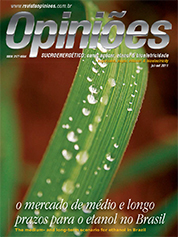Alexandre Aidar Junior
Director of BCD – Business & Commerce Development
Op-AA-29
Redemption of the fundamentals
We are experiencing a big challenge that requires much lucidity. From a trading point of view demand essentials are and will continue to be positive for all products. At the end of 2008/beginning of 2009, the planet’s urban population surpassed the rural one. This fact is occurring in developing countries that are living through this period of crisis sustaining average growth rates which are 5 to 6 times higher than those of the developed world.
These new urban societies are in search of a path to apparent development set by North American consumption standards, and intensively publicized as a success model by the movies, TV and internet industry in the last 60 years.
Obviously, there are local cultural adjustments, but all it takes is to walk the streets of the big cities of China, India, Russia, Brazil, South Africa, Malaysia, and Indonesia, to observe these features: increasingly more industrialized foods, distributed through ever growing retail networks, with high demand for electricity and liquid fuels. The planning of infrastructure projects in those countries also resorts to this model.
This fact is highly positive both for sugar – which remains as the cheapest means of food energy – and for ethanol - the best known green answer in terms of liquid fuels, not to mention local electric power to support the growth trend in our Brazil.
Tendency models for the world’s sugar market show vegetative growth in a range of 2.1 to 2.3% per year, exceeding the former levels of 1.8 to 2%, as the result of the displacement of the economic axis. This would lead us to a world demand of approximately 210 million tons of sugar in 2020, compared with currently 170.
In the domestic ethanol market, if Brazil wants to grow 3% per year, and in accordance with the current tax model, in 2020 we might be faced with a demand of about 60 billion liters, close to double the current figure.
Promising numbers, right? In theory there is room to double in 10 years. So where lies the problem? Why is our sugarcane planted area decreasing rather than increasing? It seems so obvious, so easy – all it would take is for us to obtain the funds so that the entire issue would shift to “automatic” growth! What happened?
We are faced with one of those moments of inflection when one needs a lot of serenity. We need to review our models and to very well understand the past to learn about how to be careful with respect to the above projections. The potentials exist, but the growth speeds may not be the ones wanted.
Above all, we cannot lose sight of the importance of the actual essentials of agribusiness – productivity, quality, technology, costs, knowledge of markets, logistics, climate and experience. We are reaping the severe consequences of a period of insane euphoria, dictated by plentiful liquidity resulting from an unprecedented issuance of dollars to finance the American public deficit.
Therefore, interesting financial models arose, apparently entailing high aggregation of value, in which the most basic essentials of any market appeared to become irrelevant. However, those individuals who had not forgotten them survived and even managed to aggregate some value. All others planted a virtual profit and harvested an actual loss.
Picking up reality stopped the projected growth of the industry and accelerated new consolidations as opposed to the expansions already under way. We are now feeling the more serious aspect of the financial crisis, which consists of seeking new monetary equilibrium among producer nations, while the economic axis is displaced at a variable speed.
Something to be modeled in astrophysical computers! The current sensation is that of a major default resulting from the shortage in international reserves of many countries, due to the depreciation of the dollar. Explosions in consumption (including Brazil) take place more because of expensive debt (time bomb) than because of actual accumulation of wealth.
This model, apart from inflationary, entails remnants of “bubbles” that may result in internal crises – growth pains, as yet without coverage. The current pace may be compromised. In practice, our production cost does not cease to increase (we have lost competitiveness), and the climate is showing that it cannot be ignored. Our base infrastructure is again being choked by major bottlenecks.
Logistics costs are abusive. It is time to adjust our model, improve our productivity by means of technology, prioritize the solution needed for base infrastructure, not the superfluous one, and to consistently expand our production. This is the only means to adjust our supply to these demand potentials in a more coherent and possible manner – slowly but surely!
Temporary imbalances are resolved through imports, paradoxically favored by the same factors. Straightforward arbitration! Without traumas! We did this in the 90’s. The industry is a partner in success achieved by all its players, from the producers of sugarcane to the consumer and the government. What it takes is to at long last build a tax model that is more consistent with the country’s new production scale, relieving production and consumption. The Brazil Cost must decrease. Joint action, but with each player focusing on his role.




